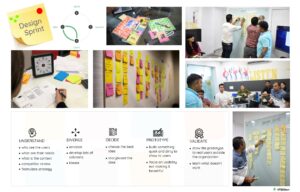It is the early morning of August and the monsoon season is in full swing in India. Gopal, a small-holding farmer in the Indore district of Madya Pradesh gazes up at the sky with a slanted hand over his eyes looking for traces of any cloud. He has sown soybean crops about a month back and the rain has been elusive. Also, caterpillars have been creeping up his small pods, nibbling on fresh shoots. He picks up his mobile phone and dials the toll-free number of Kisan Call Center (KCC) which connects him to the nearest facility.
The government of India, Ministry of Agriculture & Farmers Welfare launched the scheme “Kisan Call Centres” (KCCs) about 16 years back. Kisan call centers are working in 21 different locations in the country covering all the States and UTs. A countrywide common eleven digits Toll-Free Number 1800-180-1551 has been allotted for Kisan Call Centre. This number is accessible through mobile phones and landlines of all telecom networks including private service providers. Replies to the farmers’ queries are given in 22 local languages. Kisan Call Centre agents are known as Farm.
Tele Advisors (FTAs), and are graduates in Agriculture or allied sectors (Horticulture, Animal Husbandry, Fisheries, Poultry, Bee-Keeping, Sericulture, Aquaculture, Agricultural Engineering, Agricultural Marketing, Bio-Technology, Home Science, etc.). They possess excellent communication skills in their respective local language. If the queries cannot be answered by FTAs, they are transferred to higher-level experts. These experts are Subject Matter Specialists of State Departments of Agriculture and State Agricultural Universities. Each center handles 1000s of calls every day from farmers all over India.
Open Government Data Platform India or data.gov.in is a platform for supporting the Open Data initiative of the Government of India. There has been an increasing demand by the community that data collected with the deployment of public funds should be made more readily available to all, for enabling rational debate, better decision-making, and use in meeting civil society needs. Every call to Kisan Call Center is logged and made available for each district per month on an open government data platform.
The typical data for each district looks like the below table. Sector, Category, and Crop (sub-category), QueryType has structured data points. QueryText and KCCAns have natural language text.
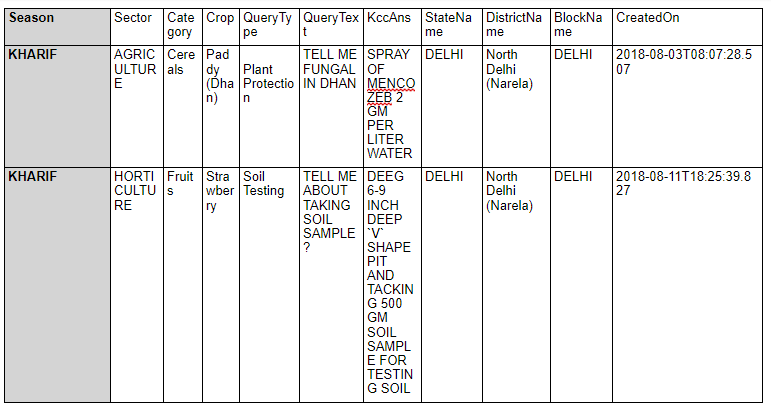

We collected the data for selected districts in the state of Madhya Pradesh for the month of August 2020. We analyzed both structured and unstructured data to gather insights.
We used natural language processing to analyze unstructured data in query text and answers. All visualizations are done using Tableau.
“Correlation is not causation” means that just because two things correlate does not necessarily mean that one causes the other. Below are examples of how to analyze such limited data and draw some insights assuming that there may be unknown factors that may have been wrongly correlated.
Insights from Structured Data
Sectors and the number of queries
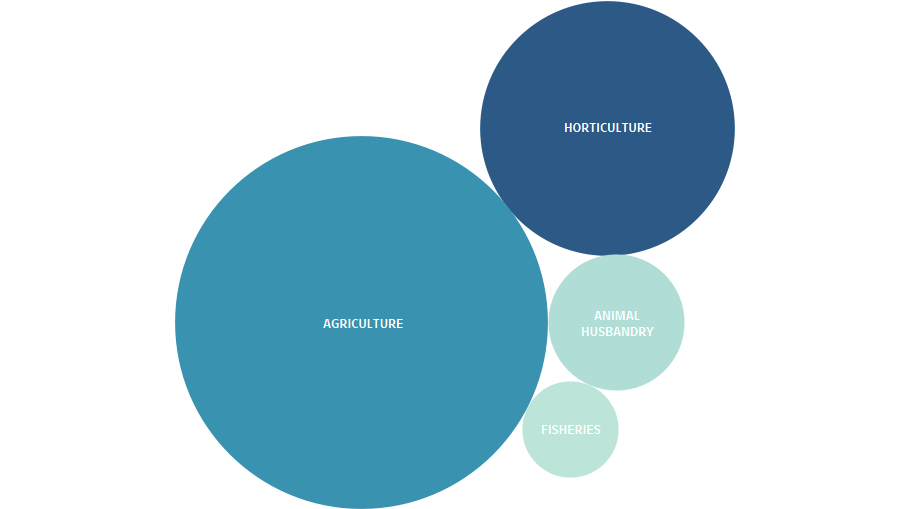
There are four major sectors – Agriculture, Horticulture, Animal Husbandry, and Fisheries. Unsurprisingly, the largest sector of agriculture has the highest number of queries followed by horticulture.
Insights
Horticulture queries are close to 75% of Agriculture queries. There is a growing demand for fruits and vegetables as the middle class grows in India.
Maximum Number of Query for Crops
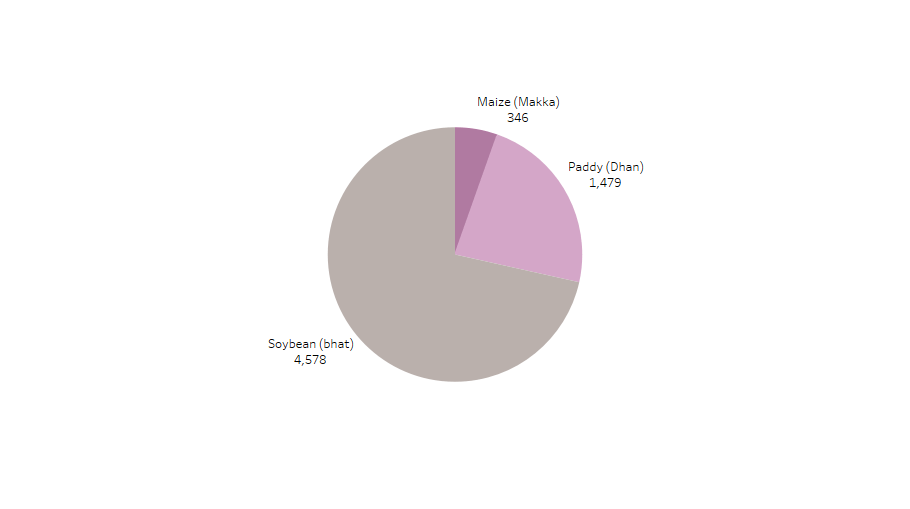
The farmers in the districts of Madhya Pradesh that we analyzed mainly called Soybean, Paddy, and Maize.
Insights
Based on the call pattern, this year, the soybean might be sown in high quantity in the districts that we analyzed followed by paddy and maze. If we collect all the available data from all the states in India, we could potentially guess the sowing patterns of various crops and its impact on commodity futures.
Call Received for each district
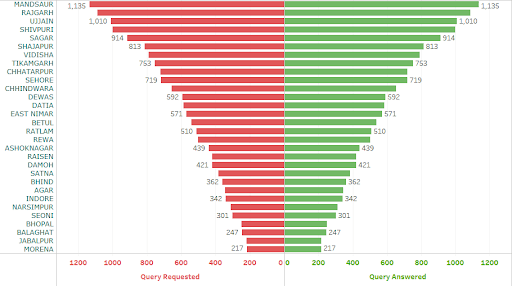
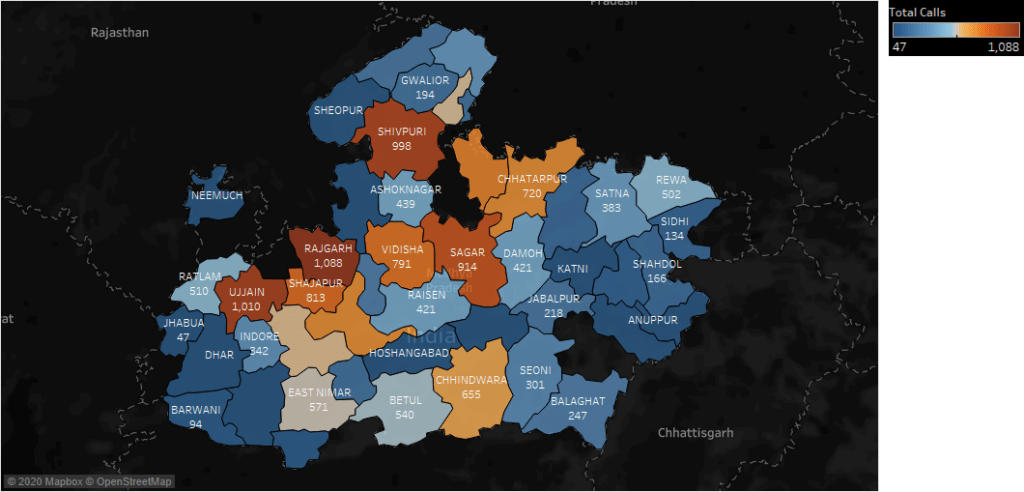
The farmers from Mandsaur, Rajgarh, and Ujjain districts had a maximum number of calls.
Insights
This could be for a number of reasons –
- These districts have a maximum farming population.
- Farmers in these districts are more aware of KCC facilities and are used to calling and getting answers.
- There are unusual incidents in these districts for which farmers need solutions
Query requested for each category
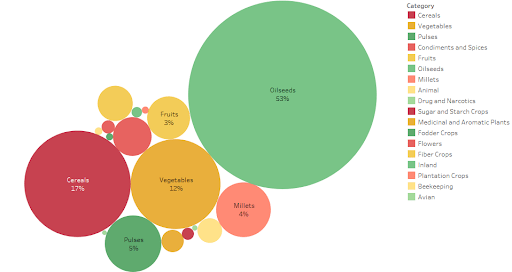
Farmers asked about oilseeds and cereals a maximum number of times.
Insights
- These districts have maximum land under oilseeds and cereals crops.
- Farmers have maximum queries for these crops
Top Query Asked by a farmer in each Sector
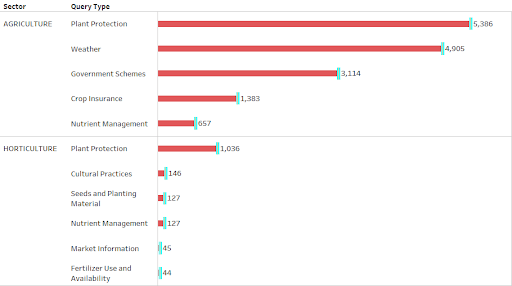
Agriculture in India is highly dependent on weather. Modern methods, techniques, and technologies have made today’s crop and livestock farms increasingly productive. But agricultural output still depends on getting just the right amount of rain and just the right amount of heat at just the right time of year.
Insights
- During the month of August, the newly sown crop is growing with fresh leaves and it’s the perfect time for pests to feast on the leaves. So maximum queries are about plant protection using pesticides.
- August is also a month when the rains may elude for days and young plants may die for a want of water. Most of the farmers in India depend on limited sources of water like borewells without any drip irrigation or efficient modes of watering the plants. This is also the reason to ask about when the rains may come so they can plan on watering the growing crops. Also for some, it may be a late sowing time and timing with rain is a perfect way to get a maximum seedling to grow out of all seeds sown. In general, whether queries are the most often asked queries throughout the year by Indian farmers which shows the importance of educating them on alternate and efficient sources of irrigation of crops.
Queries with maximum mention of crop type in each district
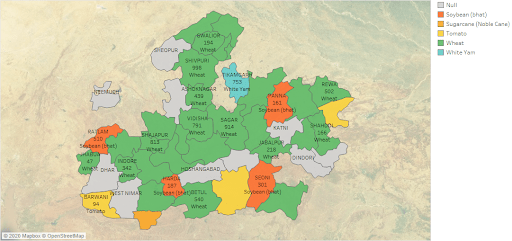
In most of the districts, we analyzed farmers calling about wheat-related queries. Panna, Seoni, Ratlam, and Harda had maximum Soybean queries.
Insights
Based on query volume for each crop type, we may be able to find out sow patterns in each district and the potential of a particular crop coming to nearby Mandies for sale.
Insights from Unstructured Data
The logged data also includes actual questions asked and answers given by the KCC experts. These are unstructured data. We decided to run Natural Language Processing (NLP) over these queries to extract deeper insights from the natural language of farmers and experts.
Repetition of Words in Queries
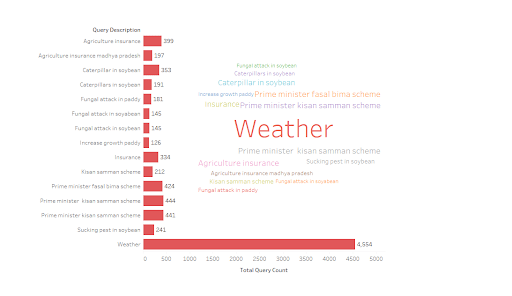
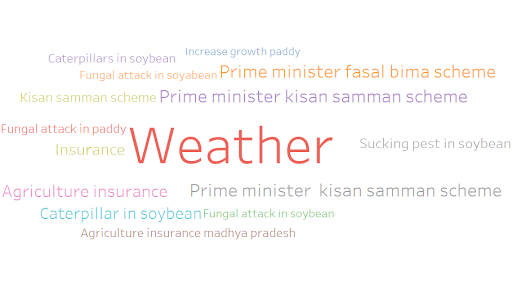
The maximum words in inquiries by farmers during calls with Kisan Call Center executives are weather and various “Prime minister schemes”.
Insights
- It is obvious how crucial Weather plays a part in Indian agriculture.
- Recently the Indian government has started multiple benefit schemes for farmers related to farm insurance, subsidies, etc. So there are a number of queries from farmers on these schemes. Based on the queries asked, the government can decide to run an ad campaign to spread awareness about the details of these schemes.
Top Entities in Query text by using ML (Named Entity Recognition)
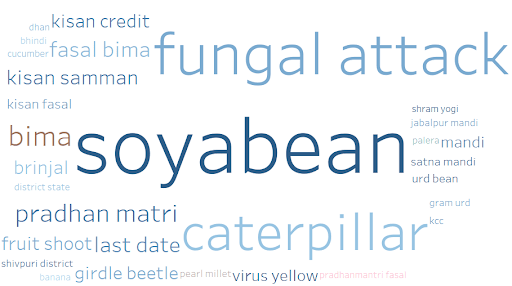
Based on the named entity recognition within the farmer queries, we can see the most talked-about words in a word cloud.
Insights
- These districts have the highest acreage of soybean.
- The most pressing concern in the month of August was a fungal and caterpillar attack.
Deeper analysis and applications
If the entire India-wide data for all the available districts is downloaded, the analysis of such data can provide nationwide crop sowing trends and the potential effect on commodity futures, region-wise disease patterns, awareness of government schemes, etc.
Input extension
- Based on inquiries before the Kharif and Rabi seasons, demand for seeds of specific crops can be forecasted and they can be procured and kept ready in regional state seed corporations.
- Demand for soil testing can be estimated based on calls related to soil testing.
- The demand for irrigation solutions like bore well digging, drip irrigation, canal water levels, and timings can be monitored and managed effectively based on calls about weather and water availability.
- Based on queries about diseases and plant growth, the input companies can align the supply chain for pesticides and fertilizers based on location.
- The input companies can run targeted advertisements based on the amount of land under specific crops, disease patterns, etc.
- Awareness and penetration of Government schemes for subsidies and insurance can be measured based on the number of queries. The government can run awareness campaigns in regions where specific queries are being asked.
Output extension
- Based on a call about specific crops along with the nationwide farmer survey samples, the regional mandi prices, and national commodity futures can be potentially extrapolated.
- The need for transportation, warehousing, and cold storage can be forecasted based on crop patterns.
- Wholesalers can procure grains from specific regions based on forecasted crop types and yields.
- The food processing plant’s location can be decided based on the availability and ease of procurement of specific crops, vegetables, and fruits.
Future applications
- Analysis of such calls augmented by the national farm, surveys, other data, and expert analysis can help the government make effective policy decisions.
- Based on the historical queries and answers, a knowledge base can be created. This knowledge base can be used to auto-answer queries using a localized text-to-speech engine.
- Based on frequent queries asked from a region, the information can be pushed using SMS in a regional language or making an outbound call.
- We can support voice-first interfaces like Alexa or Google Home with skills written in a regional language support for answering farmer queries by tapping into the expert knowledge base.
- The experts can spend time efficiently in analysis and recommendations and answering functions can be totally automated based on the analysis.
- A mobile application in a regional language can show personalized, targeted, real-time advisory based on the farmer profile and crop information that has been input into the application.
- Based on historical data on weather, crops, diseases, and fertilizers, machine learning models can be developed to predict effective combinations for the best harvesting and maximum price.
Gopal has registered with Kisan Call Center as a farmer who has sown Soybean this year. Based on this year’s monsoon conditions till now, the soil analysis of Gopal’s farm, and the type of seeds he has chosen, the expert system at KCC has formulated a customized plan for Gopal. In the morning when rain is elusive, Gopal gets a call to start his drip irrigation system. He also is recommended a spray for the pest which can potentially cause damage to his crops. These proactive measures result in a bumper harvest this year. Gopal is already thinking about receiving the best price from a wholesaler at the end of the season. When his soybean crop is ready, a call from KCC will alert him of the best time to sell.





